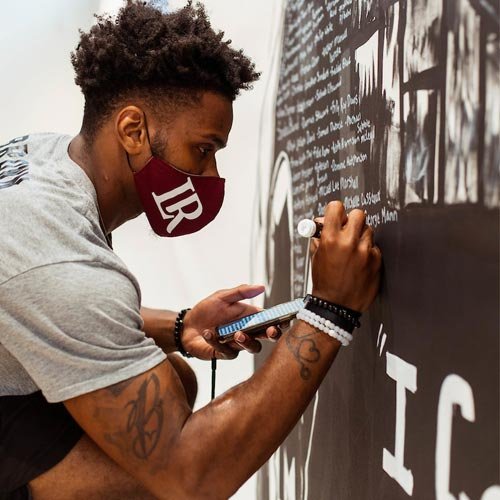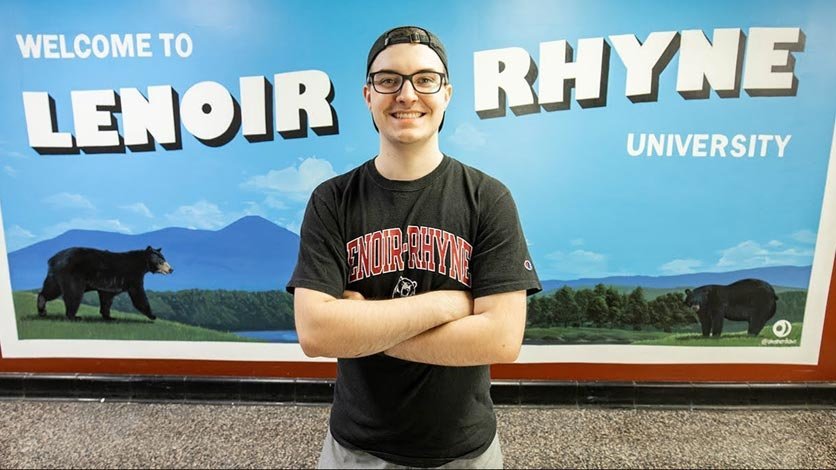Visual Art, B.A.
Art is where history, psychology, religion, politics and culture converge.
A major in visual art prepares you for a career in the contemporary art field through an interdisciplinary approach to learning. Building on the benefits of a diverse liberal arts education, you will gain an in-depth study of aesthetic principles, art history and theory, and hands-on studio experiences in drawing, painting, ceramics, sculpture, photography, design, digital practices and printmaking.
Over the course of your undergraduate education, you will achieve artistic goals through four main approaches to visual problem solving: observation, experimentation, evaluation and innovation.
Request Information
Take the next step toward completing your Bachelor of Arts in Visual Art degree at Lenoir-Rhyne University.
Get StartedTake the next step toward completing your Bachelor of Arts in Visual Art degree at Lenoir-Rhyne University.
As such, you spend your freshman and sophomore years gaining basic skills and techniques in a variety of mediums through direct observation and experimentation while studying art history, art theory and philosophy in order to gain a better contextual and conceptual understanding of their practice.
As a junior and senior, you focus on refining experiments through a process of evaluation and innovation in order to create a cohesive visual art portfolio which reflects on a contemporary issue based on your individualized interests using the medium or media of your choice.
The program offers one-on-one instruction with excellent faculty who are professionals in their field. Our instructors exhibit their works regionally, nationally and internationally. With your student peers, you will practice the art of critique and in art history classes, you will learn from great masters.
This extensive and rigorous program helps you to define and refine your skills as an innovative professional artist as you begin to realize your artistic vision and are prepared to share and further that vision throughout your career.
What you learn will go beyond the classroom with internships through local and regional businesses and non-profit organizations, plus opportunities to study abroad.
Art student Mason Strother managed his first mural project on the LR campus.
Learning Outside the Classroom
Learning in the visual art program spills over beyond the classroom. By its very nature as a discipline, the study of art requires continual integration of and exchange between the traditional classroom and the community.
You will have the opportunity to explore galleries and museums in North Carolina to gain a better understanding of contemporary art and art history.
In addition, you will regularly participate in community based service learning opportunities both on- and off-campus. As a visual art major, you;; also have the opportunity to showcase your work in a variety of different venues during their time at LR. All Visual Art majors exhibit their portfolio in a senior exhibition and are required to complete an internship in order to gain practical experience in the field.
View Community ServiceInternships & Careers
The visual arts program prepares graduates both for professional careers in the arts and graduate programs in fine arts.
Many careers benefit from the close observational and critical skills essential to the art discipline. Equally valuable is the creativity that the art graduate brings to their professional circumstances, in whatever career path is chosen. More specifically, a visual art major prepares you for professions such as art education, museum and gallery field positions, historical conservation, design careers, studio assistantships and as an exhibiting artist.
View Internships & Careers
I don't know if it has hit me yet how much of an impact it will make on other people. I just thought of it as an assignment, but as I worked through it, I realized I have a platform.
Major Requirements
A major in visual art prepares students for a career in the contemporary art field through an interdisciplinary approach to learning. Building on the benefits of a diverse liberal arts education, students will gain an in-depth study of aesthetic principles, art history and theory, and hands-on studio experiences in drawing, painting, ceramics, sculpture, photography, design, digital practices, and printmaking.
Students will achieve artistic goals through four main approaches to visual problem solving: observation, experimentation, evaluation and innovation. The Visual Art major earns a B.A. degree.
Honors
Students majoring in Visual Art who are judged qualified by the faculty may, upon invitation, elect to pursue honors work in Art. To graduate ''With Honors in Art,'' students must have a minimum cumulative GPA of 3.2, a minimum major GPA of 3.5, and complete ART 499.
-
General Education Requirements (37 hours)
Graduation Requirements (4 hours)
General Education Requirements
-
Major Requirements (51-53 Hours)
- ART 202 - Fundamentals of Color and Design
- ART 211 - Drawing I
- ART 217 - Philosophy of Art
- ART 221 - Painting I
- ART 311 - Drawing II
- ART 341 - History of Art I
- ART 342 - History of Art II
- ART 400 - Senior Portfolio
- ART 441 - ART NOW
- ART 454 - Advanced Studio Practices
- FAC 410 - Creative Futures
- FAC 490 - Internship
Choose three of the following electives:
- ART 205 - Photography
- ART 206 - Sculpture
- ART 223 - Printmaking
- ART 225 - Ceramics
- ART 302 - Fundamentals of Graphic Design Software
Choose two of the following electives:
- ART 305 - Photography II
- ART 321 - Painting II
- ART 325 - Ceramics II
- ART 383 - Selected Topics in Art
- ART 422 - Graphic Design Studio
- ART 499 - Senior Honors Thesis
-
General Elective Credits
General Electives (26-28 hours) as needed to reach 120 hours overall.
-
Total Credit Hours (Minimum) 120
On occasion, technical and/or program requirements may also meet specific General Education requirements. Please confer with your program advisor to determine which courses, if any, may be counted accordingly.
All Bachelors programs at Lenoir-Rhyne require at least 120 credit hours. If, in combination, General Education, technical, and program requirements do not generate at least 120 hours, additional credits must be completed to achieve 120 hours. These classes may be general electives, or a student may complete a minor or additional major.
Admission & Financial Aid
-
Undergraduate AdmissionOur admission team is here to assist you in making the college search process as easy as possible. Our counselors are happy to provide the information and guidance you need to submit your application, apply for financial aid and scholarships, visit and tour our campus.
-
Financial AidWe recognize that paying for college is a top concern for students and their families. Our financial aid staff is here to provide you with financial aid options and assistance to help you achieve your educational goals.
News & Events

In this update, Rev. Dr. Chad Rimmer, rector and dean of Lutheran Theological Southern Seminary (LTSS), shares exciting developments as LTSS settles into its new home on the campus of Lenoir-Rhyne University.
View More
Lenoir-Rhyne offers students opportunities to grow in themselves and give back to their communities. Hagan Suchocki '25 has embraced those opportunities with unmatched enthusiasm.
View More